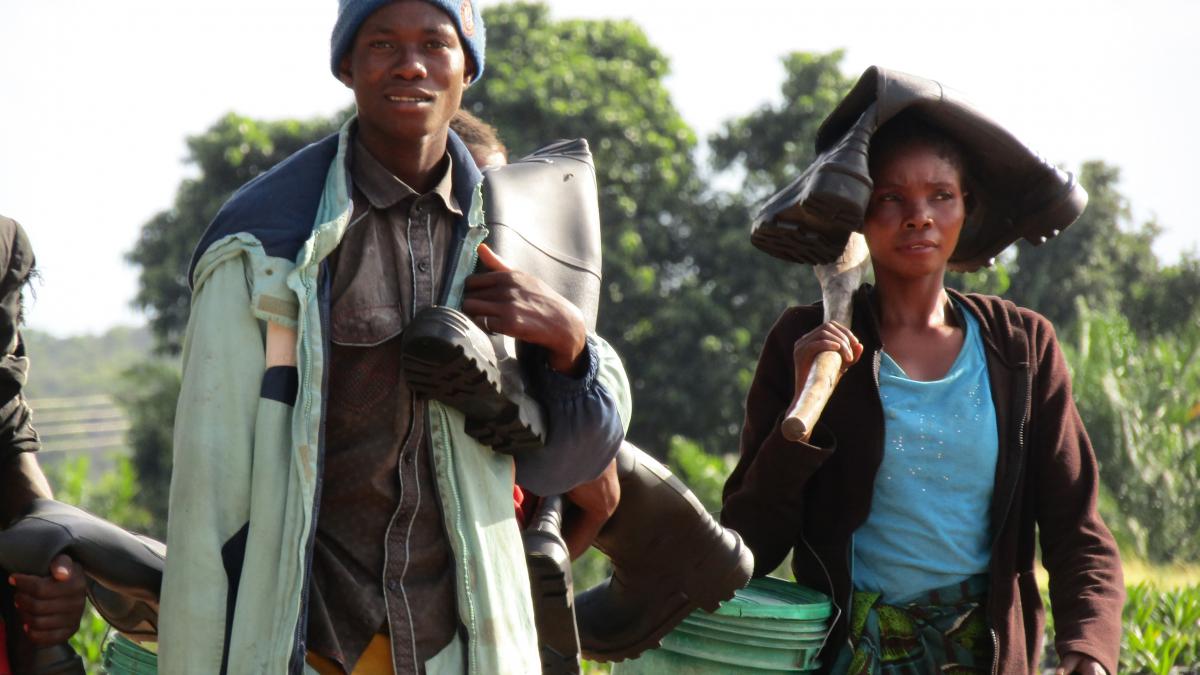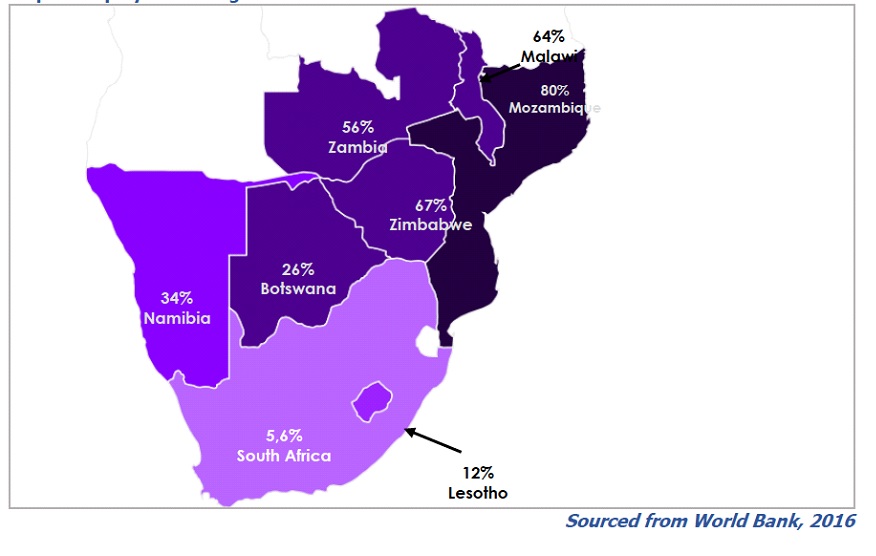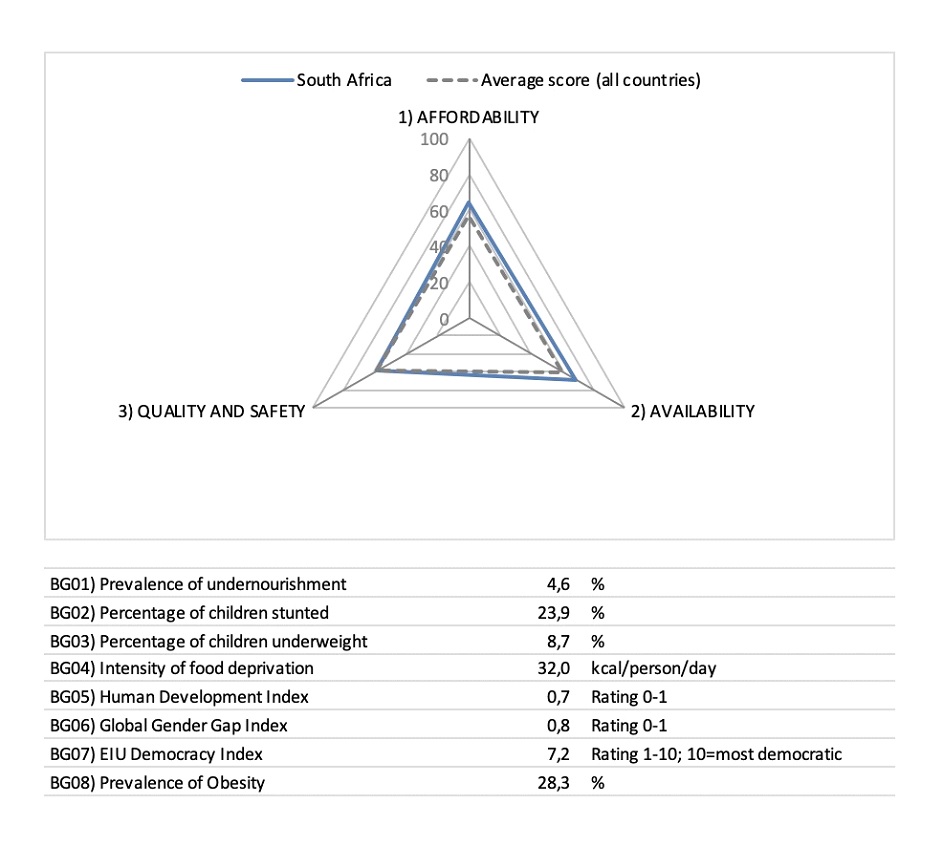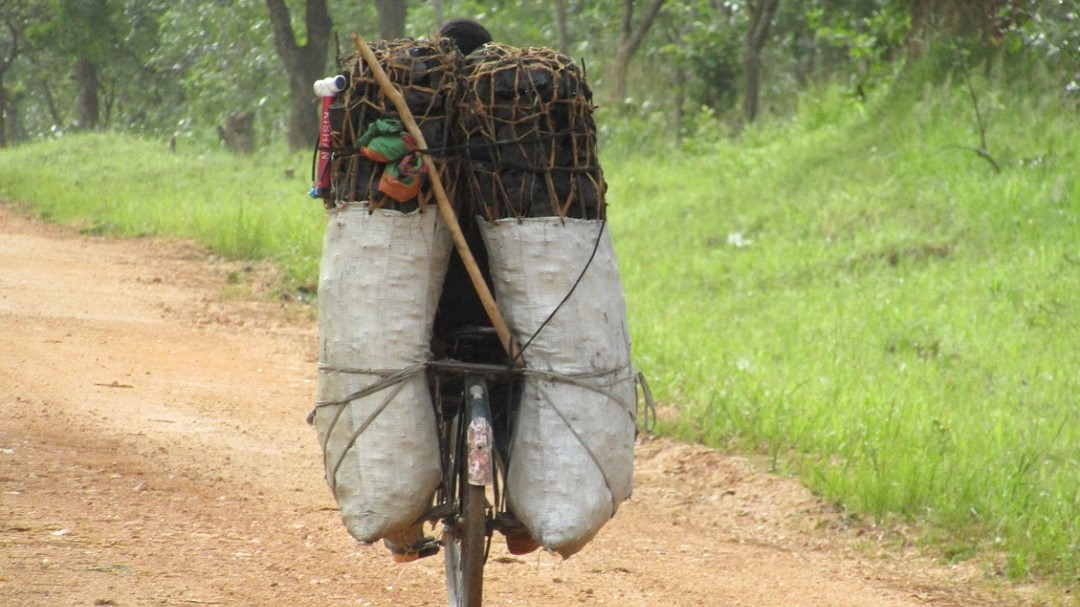
On a trip recent trip to Mpika, in the North East of Zambia, I found myself reflecting about the fate of African smallholder farmers, especially in countrysides like the one I was travelling through during this peak agricultural season in Southern Africa. The source of my reflection was the question, what is common knowledge?
More specifically, it is widely believed that agriculture has contributed to breaking the shackles of rural poverty, as seen in China, and created a foundation for rapid economic growth. But that’s not what’s happening in Africa.
Despite the presence of NGOs like my own, billions in development aid, and millions of tonnes of commodities exported out of Africa, poverty in all its forms continues to be the lived reality of smallholder farmers on the continent. In this article, I will attempt to explore the concept of local consumption-driven agricultural development.

Percentage of employment in agriculture
The uninitiated might wonder why it seems so little progress is made given the known hard working culture of African farmers, the abundance of key agricultural resources like fertile land, water, favourable climate, biological diversity, and many agro-climatic advantages. Smallholder agriculture typically tries to address two main concerns: feeding the farmer and his immediate family (food security) and earning income (growing crops purely for selling). Clearly, these issues are more complicated than first meets the eye.
Agriculture contributes about 32% of the regional GDP in the Southern Africa Development Community and consequently inhabitants making a living from agriculture number in excess of 55%. In Mozambique, this figure is as high as 80 %! Getting agriculture right, therefore, will be a proxy for getting some of these economies right.
Despite the presence of NGOs like my own, billions in development aid, and millions of tonnes of commodities exported out of Africa, poverty in all its forms continues to be the lived reality of smallholder farmers on the continent.
The Global Food Security Index (GFSI) incorporated a point of analysis around the impact of natural resources and resilience on food security with a focus on how a country is exposed to climate change and its ability to adapt. Within this group of countries, South Africa, Botswana, Angola, Tanzania, Mozambique, Zambia, Malawi and the DRC (in order of ranking ) feature from Southern Africa. The ranking, however, does not correlate with agro-climatic potential at all.
In fact, it is an inverse relationship. Countries like South Africa (45th and highest ranking African country), and Botswana (52nd) are known for their poor agro-climatic potential, while Angola (92nd), Tanzania (98th), Mozambique (101st), Zambia (104th) and Malawi (107th) and the DRC (112th) offer some of the best agro-climatic conditions in the world. This is further proof that the connection between agricultural and economic potential lies elsewhere.
Starting with Zambia
A country like South Africa, although ranking as the most food-secure country on the continent, still reports disturbing statistics. Almost 5% of the population is undernourished, and even more concerning, almost 24% of children are stunted. That’s in a country with a 28% prevalence of obesity! (Source: GFSI 2018)
South Africa’s high scoring in the food security index seems to rest mainly on the presence of food safety net programmes (social protection), access to financing for producers, public expenditure on research and development (R&D) , sound agricultural infrastructure, clear nutritional standards, and, of course, relatively low corruption and a high democracy index.

A comparison between South Africa and Zambia, for example, indicates that there is still a lot of work that remains to be done in Zambia. While there is definitely progress made on the availability of food, the quality, safety and affordability are still a concern.
The situation in Zambia is dire. The country scores low on:
-
food consumption as a percentage of household expenditure
-
food safety net programmes
-
sufficiency of supply
-
public expenditure on agricultural R&D
Other challenges include food safety, micronutrient availability, diet diversification and protein quality. The impact of not getting these things right is reflected in a 45% prevalence of undernourishment, and an even more shocking fact that 40% of children are undernourished!
Furthermore, Zambia’s management of its land, grassland and forest resources has also been flagged as being extremely weak. This situation can only result in conditions that are worse than what is being observed presently.
Almost 5% of the population is undernourished, and even more concerning, almost 24% of children are stunted. That’s in a country with a 28% prevalence of obesity!
So maybe the task of feeding one’s self is the first frontier to be conquered before we even look at addressing the production-for-resale challenge. Our view is that by carefully understanding local food consumption patterns, we can also improve the incomes of farmers by better connecting them to local demand.

A quick look at supply chain solutions
Livestock
South Africa has a per capita consumption of beef and chicken of 20 kg and 38 kg per person per annum, which has been growing steadily for the last few decades. However, for South Africa to meet this growing consumer demand, on average 300,000 heads of young livestock are imported from Namibia to supply feedlots who are key to meeting the insatiable demand for beef.
I wonder what would it mean for South Africa if these weaners came from smallholder farmers in the Eastern Cape, the North-West, KwaZulu-Natal, Limpopo and Mpumalanga, instead. After all, these farmers manage at least 40% of the national herd. At an average value of ZAR 7,500 rand per weaner, this would inject ZAR 2.2 billion rands annually in areas that currently depend on social transfers for sustenance.
Poultry
The poultry scenario has been subject to a lot of heated debate as well, but in essence, poultry imports account for anything up to 30% of local consumption. This happens in a scenario where the local industry has not effectively integrated smallholder farmers, limiting their participation in live poultry sales, which does not even make up 5% of local supply.
If we assume that 30% of local supply is equivalent to 500,000,000 kilograms of chicken, then there is potential for up to 330,000,000 birds that could be produced by small-scale farmers. For example, a small-scale farmer doing eight cycles of 1,000 birds will produce 8,000 birds per annum or 12 metric tonnes of chicken per year. So, potentially 42,000 small-scale farmers could participate in the industry, earning over ZAR 6 billion rands.
While these are superficial calculations, we need to seriously reconsider why have we decided that we can’t support 42,000 farmers that produce 1,000 birds per cycle.
The local market is already strongly demanding the product but our systems a
re not responding. Instead, scarce foreign currency is spent on importing what our farmers can, and want to produce.
Rice
Our region also has a love for rice, which has become a significant dietary starch. Available data indicates that Southern Africa has 650,000 hectares under production on average with Mozambique and Malawi being the leading producers.
However, when one looks at their productivity, only 400 kg and 1,600 kg are produced per hectare respectively. These are very low figures when compared with South East-Asian producers who average between 3,500 and 4,000 kg per hectare. When one considers that the region imports 1.7million metric tonnes of rice per annum, even a yield increase to 1.5 metric tonnes per hectare would make the region self-sufficient in rice.
Perennial lack of investment in imported varieties and agriculture methods means that the potential for rice as a means for income generation in countries like Mozambique, Zambia and Malawi remains untapped. The local market is already strongly demanding the product but our systems are not responding. Instead, scarce foreign currency is spent on importing what our farmers can, and want to produce.
Milk
The issue of stunting and malnourishment featured prominently in the GFSI report is strongly linked to a lack of dietary diversity and accessibility to nutritious food. Milk being one of the more balanced foods available is much too scarce across the region.
While South Africa has a surplus of supply, most other countries in the region rely on imports to meet demand. Out of the average 4.3 million litres of milk consumed in the region annually, almost a third comes in as imported powder and long-life milk.
My country of birth, Zimbabwe has a shortage of 70 million litres of milk annually to meet local demand. Conversations with the Zimbabwe Association of Dairy Farmers indicate that just an extra 12,000 dairy cows in production would plug this gap. The total investment would be about USD 12 million dollars, which pales in comparison when one considers the import costs and the drain on the foreign exchange market.
More importantly, a vibrant dairy sector could create a platform for the revival of the school milk system of the 70s and 80s where every school child received a glass of milk a day. This would contribute to reduced malnutrition and could be replicated across the region.
The question we need to ask is, can’t 12 million dollars be found to fund these cows? Or better still, 600 new dairy farmers, with 20 cows each, could diversify their farming income from other less viable pursuits and meet existing local demand at the same time!
Our team at the Solidaridad Southern Africa Regional Expertise Centre is hard at work to come up with solutions for these challenges, utilizing technical experts and innovation teams that focus on digital solutions, climate-smart interventions, gender and youth inclusivity and impact investments. We are convinced that, as our colleague calls it, “Radical Local Consumption” can save Southern Africa’s farmers and spark an industrial revolution.
Follow Mandla Nkomo on LinkedIn to read more of his articles.
